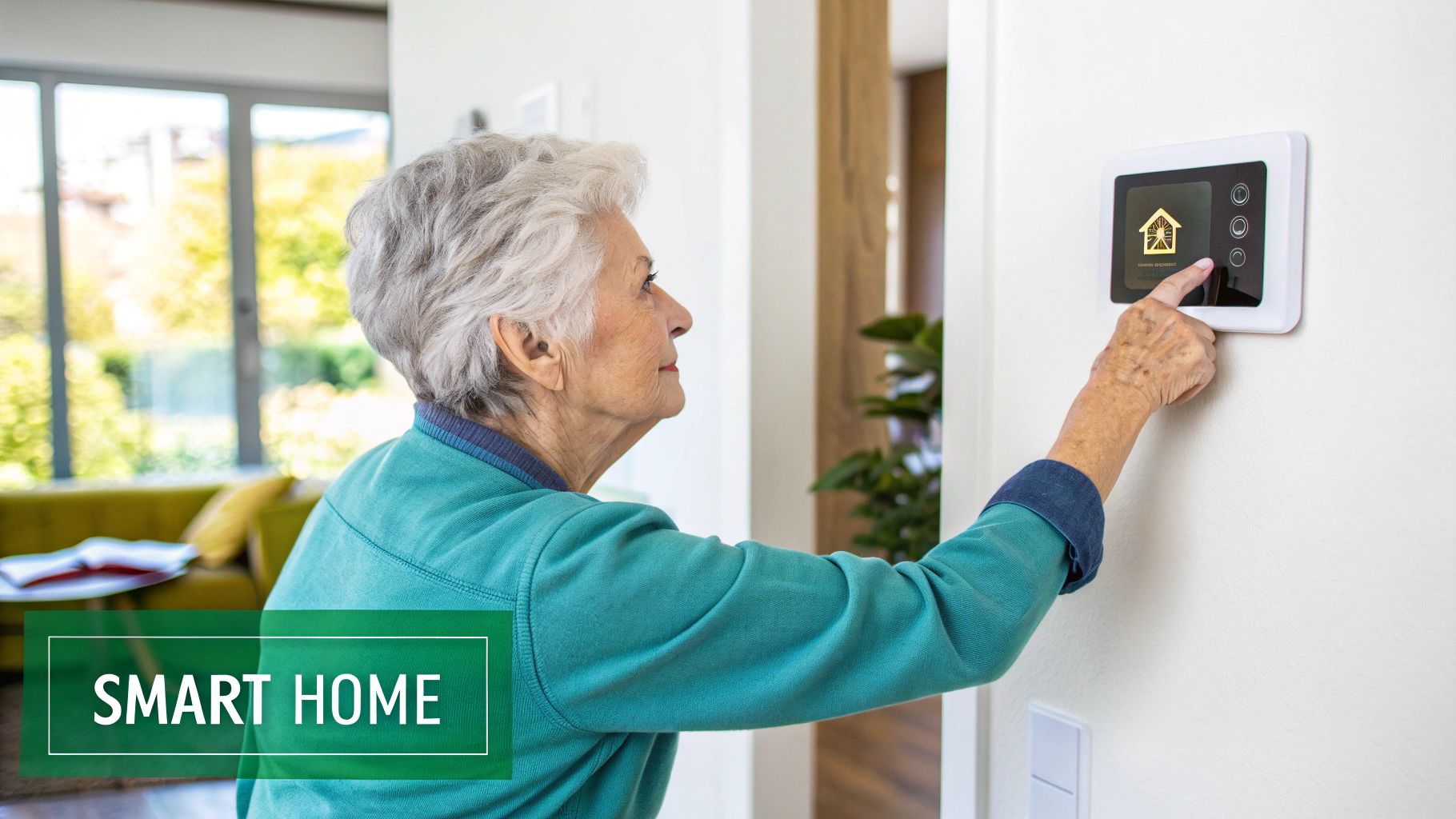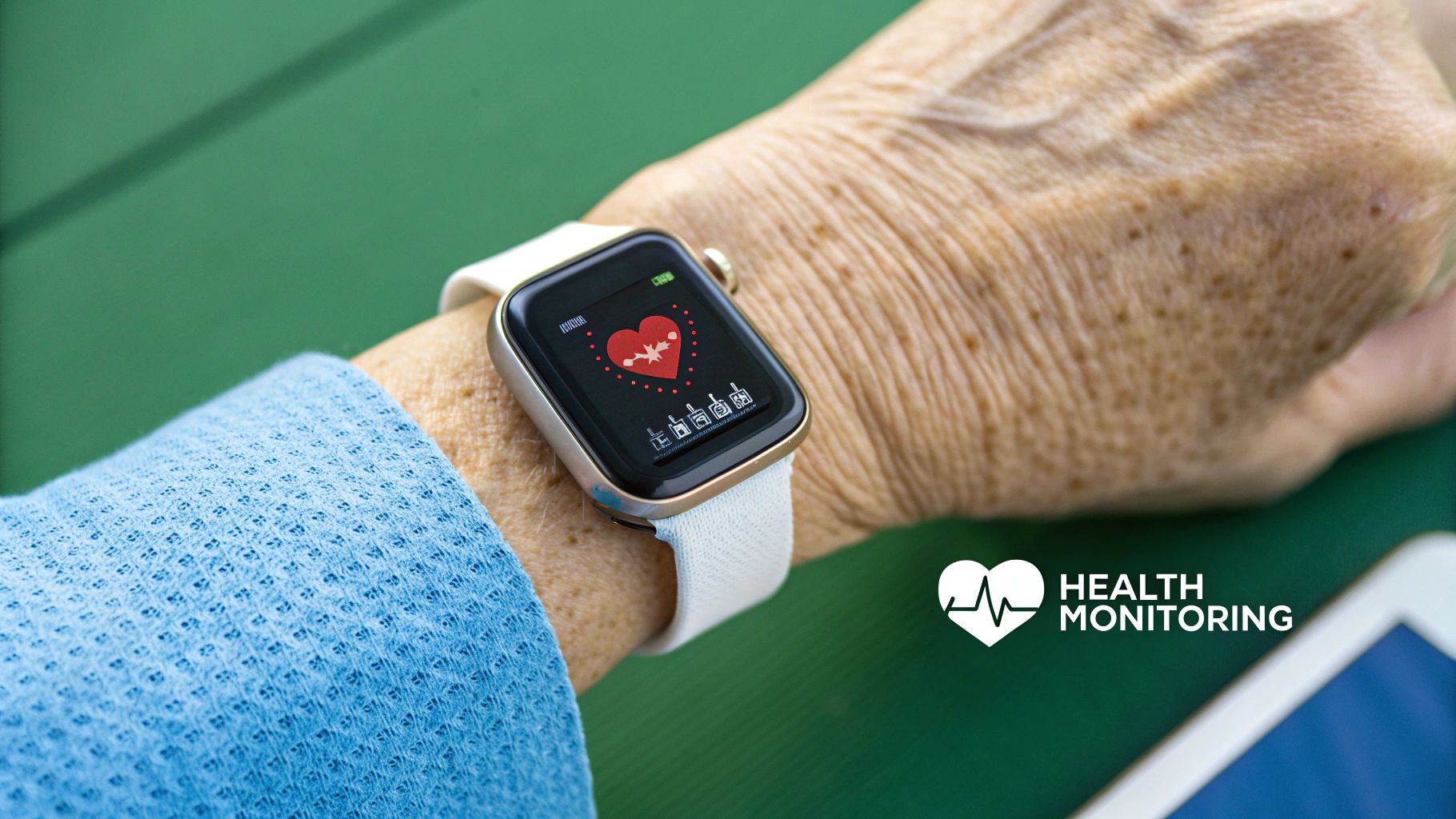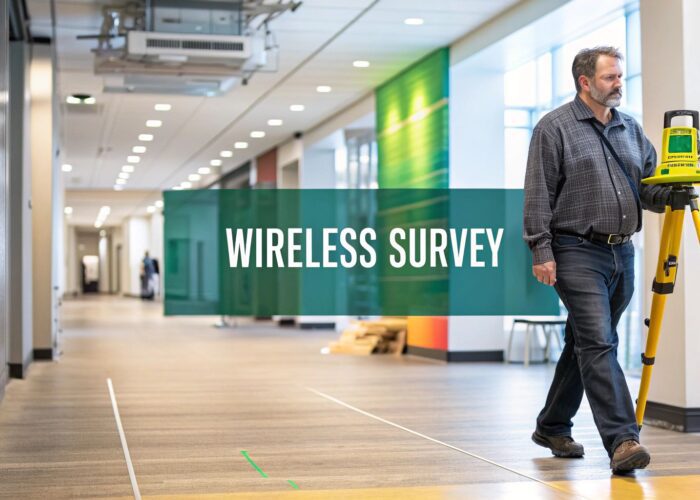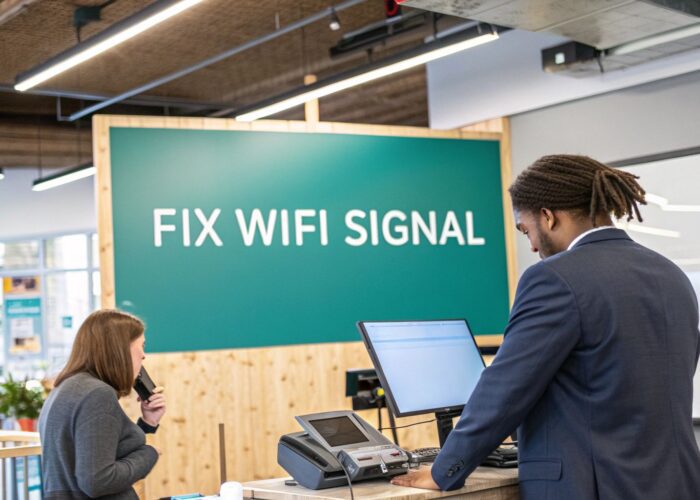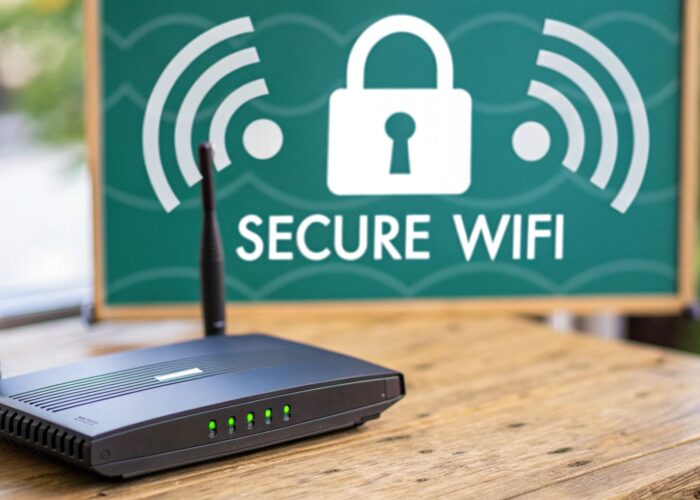Hey there! Let's talk about senior living technology. It isn't just one single thing; it's a whole collection of cool tools and systems working together to make a community more connected, safer, and a more engaging place to live. We're talking about everything from the essential Wi-Fi connectivity that everyone expects, to smart security systems, telehealth platforms, and even apps that keep residents in the loop—all of it designed to boost quality of life and make the community run smoother.
The New Era of Connected Senior Living
Welcome to the future of senior care, where technology is no longer just a nice-to-have amenity; it's the very foundation of a thriving community. Today's best senior living environments are built to be vibrant, interactive, and secure, and believe it or not, none of that is possible without a powerful digital infrastructure.
Think of it as the community’s central nervous system. Without it, nothing else really works.
This foundational layer starts with a rock-solid, secure Wi-Fi network. Solutions from top-notch providers like Cisco and Meraki deliver the kind of reliable, enterprise-grade connectivity that you'd typically find in big BYOD corporate offices, busy retail stores, or university campuses in the education sector. This is the backbone that supports a resident’s video call with their doctor, the smart thermostats in their apartments, and the digital calendars that keep everyone connected to community events.
Building the Digital Backbone
Just like a busy retail store uses Wi-Fi to manage its inventory and offer guest access, a senior living community has to juggle a huge variety of digital demands. Every video call to family, every movie streamed on a tablet, and every alert from a safety pendant depends on that underlying network.
A strong network makes sure all those experiences are smooth and dependable, which is crucial for building trust and keeping residents happy. It has to handle a massive number of personal devices (BYOD) and mission-critical health applications without a single hiccup.
The digital backbone isn't just about providing internet access. It’s about enabling a higher standard of care and a more connected lifestyle. Every other piece of technology in the community is built right on top of it.
Evolving Expectations for Modern Care
The entire industry is going through a massive shift. We have a growing aging population, and both residents and their families have much higher expectations for what technology can and should do.
Starting in 2025, we're going to see a huge surge in the adoption of more advanced tech. Things like smart access control, telehealth services, AI that can predict health needs, and remote monitoring are completely changing how care is delivered. With telehealth and wearable health trackers becoming standard, strong cybersecurity and seamless data integration are no longer optional—they're essential for providing great care and staying compliant.
This is where more advanced networking tools come into the picture. Concepts like Captive Portals for easy guest access and secure Authentication Solutions like IPSK and EasyPSK are now vital. These tools, which have been perfected in other industries, are exactly what senior living communities need to create a secure, user-friendly digital experience. This shift to more sophisticated, cloud-managed IT isn't just a trend; it's a necessity for any community that wants to be ready for the future.
Enhancing Resident Security and Connectivity
Great senior living technology solutions do more than just provide an internet signal; they build a digital environment that’s both welcoming and incredibly secure. Think about the guided, simple Wi-Fi experience you have at a high-end coffee shop or a university campus. That seamless and secure first impression is exactly what modern senior living communities should aim for.
It all starts with a rock-solid network. Solutions from industry leaders like Cisco and their cloud-managed Meraki platform really set the standard here. These systems are built to handle the demands of hundreds of users and devices at once, making them a perfect fit for a vibrant senior community. This foundation has to be stable and reliable for everything else to work.
The Digital Welcome Mat: Captive Portals
Often, the very first interaction a new resident or visitor has with your community's network is through a Captive Portal. This is simply the branded sign-in page that pops up before they can get online. You’ve seen them in retail stores offering discounts or in education for student logins. In senior living, it acts as a digital welcome mat.
A Captive Portal handles a few important jobs:
- Sets a Professional Tone: It’s a branded, professional front door to your digital services.
- Manages Guest Access: It gives visitors a separate, secure way to get online without touching the private resident network.
- Guides New Residents: It can walk new residents through a simple, one-time setup to securely connect their personal devices.
This controlled entry point is your first layer of defense, making sure only authorized people can connect.
Securing Every Connection with Modern Authentication
In the old days, many communities just used a single, shared Wi-Fi password for everyone. Honestly, this approach is a security and management nightmare. If one person shares that password, your entire network is exposed. This is a problem the BYOD corporate world and education sectors figured out how to solve years ago.
The infographic below shows just how critical this secure connectivity is for services like telehealth that directly impact residents' well-being.
As you can see, reliable and secure connections are the bedrock that makes convenient, high-quality virtual healthcare a reality for seniors.
This is where modern Authentication Solutions are a game-changer. Instead of a one-size-fits-all password, these systems give each resident their own unique "key" to the Wi-Fi.
Think of it this way: you wouldn't give every resident the same master key to every apartment. The same logic applies to your digital community. Each person deserves their own secure, private access.
Technologies like Identity Pre-Shared Keys (IPSK) or EasyPSK make this happen. With these solutions, every resident gets a single, unique password that works for all their devices—their laptop, tablet, and smartphone. If a resident moves out, their key is simply turned off without disrupting anyone else.
When it comes to authenticating dozens or even hundreds of personal devices, the difference between old and new methods is stark.
Comparing Wi-Fi Authentication for Senior Living
| Feature | Traditional Shared Wi-Fi | IPSK and EasyPSK Authentication |
|---|---|---|
| Security | Low. One compromised password exposes the entire network. | High. Each user has a unique key; a breach is isolated. |
| User Experience | Simple, but requires re-entering the password on all devices if it changes. | One-time setup. Users connect all their devices easily and securely. |
| Management | Difficult. Changing a password requires updating every user and device. | Simple. Onboard or offboard users individually with no impact on others. |
| Visibility | Poor. It's hard to know which device belongs to whom. | Excellent. Admins can see exactly which devices are connected to each user. |
The move to a modern authentication system like IPSK is a clear win, enhancing security while making life easier for both residents and staff.
By adopting these proven methods, senior living communities can offer a far superior digital experience. This not only protects residents but also safeguards the entire community's digital backbone, including critical systems like security cameras. To learn more, you can see how Meraki security cameras fit into a securely managed network. Ultimately, this level of security and simplicity delivers invaluable peace of mind for residents and their families.
Boosting Resident Engagement and Wellness
Beyond just keeping people safe, the best senior living technology solutions are the ones that actually make life better every day. We're talking about technology that builds friendships, keeps minds sharp, and encourages physical health. It’s the key to transforming a community from a place that's merely safe into one that's truly vibrant and full of life.
This all starts with simple, reliable access. Picture smart tablets in every room, pre-loaded with apps for the community. Residents can pull up event calendars, see what’s for dinner, or start a video call with family with a single tap. These tools are incredibly effective at reducing isolation and keeping everyone connected to the community's social rhythm.
But here’s the thing: the experience has to be seamless. A video call with a grandchild that keeps freezing is worse than no call at all. That’s why a rock-solid Wi-Fi network, built on enterprise-grade hardware from companies like Cisco and Meraki, is non-negotiable. It’s the invisible backbone that ensures every digital interaction is a good one.
Creating Immersive and Connected Experiences
Modern tech can bring the world to your residents. Imagine someone taking a virtual reality (VR) tour of the Louvre or strolling through their childhood neighborhood, all from the comfort of their favorite armchair. These kinds of immersive experiences are fantastic for mental stimulation and sparking a bit of shared magic.
On a similar note, smart fitness trackers and wellness apps can make an active lifestyle more fun by turning movement into a game. As more residents bring their own devices—a trend known as BYOD—the network has to handle all those connections securely. We're actually borrowing a page from the corporate and education playbooks here.
Think about it: a university campus has to securely connect thousands of student devices. A senior living community faces the exact same challenge, needing to provide a smooth and safe digital experience for every resident's personal tech.
We can use authentication methods like IPSK and EasyPSK to give each resident their own private key to the network. This keeps their devices and data safe, freeing up your staff to focus on what they do best: creating amazing experiences for the people who live there.
Personalizing the Resident Journey
A great network does more than just get people online; it allows you to create a more personal and responsive environment. Once that solid digital foundation is in place, you can roll out more advanced tools. For example, you can greet residents with a branded Captive Portal that shows a daily welcome message or highlights activities based on their known interests.
This kind of personalization makes people feel seen and valued. It’s a strategy the retail world has used for years to build loyalty, and it works just as well in a senior living community. When you understand what your residents care about, you can deliver a living experience that feels truly made for them. To see how this works in practice, you can learn more about improving customer experience personalization with network data.
To really build that sense of community and help residents manage their health, looking into the best patient engagement platforms is a smart move. These platforms give you tools for:
- Centralized Communication: Easily send out community-wide announcements or personal reminders.
- Wellness Tracking: Let residents keep an eye on health stats and share them with caregivers or family.
- Social Networking: Help create private online groups for residents who share hobbies, like a book club or gardening group.
At the end of the day, these senior living technology solutions are about so much more than convenience. They’re about empowering residents, fighting back against loneliness, and nurturing a dynamic community spirit. Investing in a strong digital foundation isn't just an IT upgrade; it's an investment in a happier, healthier, and more engaged community.
Making Life Easier for Caregivers and Staff
While we often focus on the technology residents use, the tools that support caregivers and staff are just as important. In fact, they're the engine room of the whole operation. When your team is well-supported and efficient, the quality of care goes up dramatically.
The right senior living technology solutions work behind the scenes to lift administrative burdens off your staff's shoulders. This frees them up to focus on what they do best: caring for people.
It all starts with a single, unified digital backbone. Imagine your electronic health records (EHRs), mobile communication apps, and scheduling software all running smoothly on one dependable network. Staff can pull up a resident's chart on a tablet from anywhere on campus, message a colleague for a quick consult, and spend far less time chained to a desk.
This isn't a new concept. We're borrowing proven ideas from the BYOD corporate world and education sectors, where secure, mobile access to critical information is just how things are done. The foundation for all this is a rock-solid network built with reliable hardware from providers like Cisco and Meraki. This ensures sensitive data is both protected and instantly available to the right people.
Creating a Secure and Efficient Digital Workspace
Just like residents, your staff and visiting medical professionals need secure, reliable access. A thoughtfully designed network handles every connection with purpose. For instance, a Captive Portal can provide a visiting physical therapist with secure, temporary Wi-Fi access that’s completely separate from the main staff and resident networks. It's a simple, effective way to keep your core network locked down.
For staff devices, modern Authentication Solutions like IPSK or EasyPSK are game-changers. Each caregiver gets a unique key for their work phone or tablet. If a device is ever lost or an employee moves on, you can revoke their access in seconds without disrupting anyone else.
This approach builds a secure, segmented digital environment where the right people get the right information at precisely the right time. It’s about creating an operational framework that is both flexible and fundamentally safe.
This kind of structured access control has long been a staple in industries like retail and higher education, where managing thousands of devices and user roles is just another Tuesday. Adopting these battle-tested strategies helps senior living communities protect sensitive data while empowering staff with the mobile tools they need to be truly effective.
The Power of Data in Modern Senior Care
Beyond just making daily tasks easier, technology is unlocking incredible new ways to anticipate needs and fine-tune care. When you start integrating data from different sources—from EHRs to wellness sensors—you get a much clearer, more complete picture of both resident health and community operations. This opens the door to proactive, data-driven decisions that can genuinely improve people's lives.
This shift toward data-driven decision-making is becoming a cornerstone of modern senior living technology solutions. It allows communities to track health metrics, resident preferences, and even staff performance in real-time, leading to more personalized care plans and smarter use of resources. As noted in industry reports on the future of age-in-place technology, investing in data quality and business intelligence tools helps automate tedious manual tasks and uncovers insights that save both time and money.
This analytical approach helps you spot patterns you might otherwise miss. For example, AI-powered tools can:
- Predict potential health issues by analyzing subtle changes in a resident’s behavior or vital signs.
- Optimize staffing schedules by looking at historical data of when residents need the most support.
- Identify fall risks before an accident happens, allowing your team to intervene.
By using data to become more predictive, communities can move from a reactive "fire-fighting" model to a proactive one. This doesn't just lead to better health outcomes for residents; it also creates a more supportive and manageable workplace for staff, which is a huge factor in employee retention. Our guide on improving operational efficiency dives deeper into these strategies.
Ultimately, a streamlined operation isn't just about saving time or money. It's about creating a better, safer, and more compassionate community for everyone.
A Smart Investment for the Future of Senior Living
Investing in robust senior living technology is far more than a simple upgrade to modernize a facility. It’s a strategic financial move that delivers a clear return. While the cost savings from making operations more efficient are great, the real prize is gaining a serious competitive edge in a market that's growing by the day. It's really about future-proofing your community for the next generation of residents.
The simple truth is this: the incoming wave of residents, the baby boomers, have completely different expectations. They're comfortable with technology and have grown accustomed to the seamless connectivity they have at home, at work, and even at their favorite coffee shop. When they choose a new community, they expect it to meet—if not beat—that standard.
Meeting the Demands of a New Generation
This fundamental shift means a community's digital infrastructure has become a key selling point. When families are weighing their options, they’re not just looking for excellent care. They're looking for communities that use technology to keep their loved ones safe, engaged, and connected to the outside world.
It all starts with a strong network foundation, built with enterprise-grade gear from providers like Cisco and Meraki. This is the backbone that supports everything from telehealth appointments and smart safety alerts to the simple joy of a buffer-free video call with the grandkids. This isn't just an amenity anymore; it's a core part of the resident experience and a huge factor in attracting new people.
An investment in technology is really an investment in your community’s reputation and its long-term appeal. It sends a clear signal that you’re committed to a modern, high-quality living experience that meets the standards of today's families.
The Financial Case for a Scalable Foundation
The global senior living market is on track for some serious growth, driven almost entirely by this demographic shift. Projections show the market is expected to grow by around USD 130.9 billion between 2025 and 2029. Technology and AI are at the heart of this expansion. This growth is being fed by a rising demand for more advanced long-term healthcare, creating a massive opportunity for communities that invest wisely. You can dig deeper into these market trends and the impact of AI in recent reports.
This is where AI-powered tools become so crucial. They help manage resources intelligently and provide personalized care on a larger scale. By using data analytics, communities can fine-tune staffing schedules, anticipate what residents might need, and just generally run a tighter ship.
This powerful mix of operational tools and resident-facing tech creates a strong return on investment.
- Lower Operational Costs: Automation and data insights help you put resources where they're needed most, cutting down on administrative waste.
- Higher Occupancy Rates: A community that embraces technology is a huge draw, helping you attract and keep residents.
- Better Staff Retention: Giving your team better tools to do their jobs makes for a more supportive workplace, which helps reduce turnover.
Laying this foundation now is absolutely critical. Much like the BYOD (Bring Your Own Device) corporate and education sectors before it, senior living is now grappling with a growing flood of personal and operational devices. Our guide to IoT solutions in senior living explains how a scalable network can handle this increasing complexity. A secure, flexible technology framework isn't just an optional upgrade anymore—it's the essential investment that will separate the leading communities from the rest.
Choosing the Right Technology Partner
Bringing a comprehensive tech strategy to life can feel like a massive project, but the right partner makes all the difference. This isn’t about just buying a box of equipment. It's about finding a team that truly gets the unique rhythm and demands of a senior living community. Your partner should be just as obsessed with user-friendly interfaces and regulatory compliance as they are with the technical specs.
The real goal here is to build an infrastructure that can grow with you—something that’s ready for whatever comes next. That usually means starting with a solid foundation from trusted names like Cisco and Meraki, whose hardware is built to scale. A great partner will help you map out a technology journey that actually makes sense for your residents, your staff, and your budget, ensuring every dollar you spend adds real, tangible value.
Finding a Partner Who Understands Senior Living
A senior living community isn't a standard corporate office or a retail store, and its IT needs are worlds apart. Your technology partner absolutely must appreciate the importance of simplicity for residents who might not be digital natives. They need to understand that your network isn't just for streaming movies; it's a lifeline that supports critical health monitoring and emergency alert systems.
When you're interviewing potential partners, get specific. Ask them about their direct experience with:
- Secure BYOD Environments: How do they plan to safely manage hundreds of personal devices brought in by residents?
- Authentication Solutions: Can they walk you through how IPSK or EasyPSK will make life easier for both residents and your on-site staff?
- Seamless Onboarding: What’s their process for using a Captive Portal to give new residents and visiting family a warm, easy welcome to the network?
A partner who can confidently dive into these topics—and even draw smart parallels from their work in other demanding fields like education—is a partner who knows how to build a digital environment that’s both secure and genuinely helpful.
The right technology partner doesn't just sell you hardware. They act as a guide, helping you build a digital ecosystem that enhances care, fosters connection, and improves daily life for everyone in your community.
Your Roadmap to a Connected Community
As we’ve seen, the path to a modern, tech-forward community is actually quite clear. It all starts with that foundational layer of secure, reliable Wi-Fi. From there, you build on it with modern authentication that protects every single user while simplifying management for your team. The positive effects ripple out, touching residents' lives, empowering your staff, and ultimately, strengthening your bottom line. When looking at tools to make your staff's job easier, a Voice Charting Software Comparison can offer some great insights into what might work best for your facility.
By choosing a partner who provides robust senior living technology solutions, you’re doing more than just an IT upgrade. You're investing in a community that’s more engaging, more secure, and more competitive—one that’s ready for the challenges and opportunities just around the corner. This roadmap will guide your journey, making sure every decision you make supports your core mission of providing exceptional care.
Common Questions We Hear
Diving into the world of senior living technology often brings up a few key questions. Let's walk through some of the most common ones we encounter, clearing up the path to creating a more modern, connected, and secure community.
How Can We Justify the Cost of a Major Wi-Fi Upgrade?
It's natural to look at the price tag of new infrastructure and hesitate. But it’s best to think of a network upgrade as a foundational investment, not just another expense. A robust, community-wide Wi-Fi network, built with reliable hardware from providers like Cisco and Meraki, is the digital backbone that makes everything else possible.
The payoff shows up in a few key areas. You'll notice smoother day-to-day operations, find it easier to keep great staff, and see big improvements in resident safety systems. Maybe most importantly, it becomes a massive selling point, helping you stand out to prospective residents and their families who now expect these amenities as standard.
What Exactly Is a Captive Portal, and Why Do We Need One?
Ever connected to Wi-Fi at a hotel or coffee shop and had to click through a branded welcome page first? That's a Captive Portal. It’s essentially your community's digital front door, and it's a critical tool for both security and network management that's been proven in industries like retail and education.
For a guest, it’s where they agree to your terms of service before getting temporary access. For a new resident, it's the first friendly handshake in a secure onboarding process. It guides them through connecting all their personal devices (a BYOD corporate model) using modern Authentication Solutions like EasyPSK. It immediately establishes a professional, organized, and secure environment.
How Can We Make Sure New Technology Is Actually Easy for Residents to Use?
This is a big one, and the answer has two parts: choosing the right tools and providing great support. When you're looking at solutions, prioritize those with simple, intuitive designs—think large, clear icons and straightforward navigation. Your technology partner should have real experience working with seniors and understand their specific needs.
But the technology is only half the battle. You have to be ready to support your residents with patient, hands-on training. Offer group workshops for the social learners and one-on-one sessions for those who need a bit more personal attention. Simple, large-print guides can be a lifesaver, too. The goal is to build confidence and empower residents, not overwhelm them.
Why Are IPSK and EasyPSK So Much Better Than a Single, Shared Password?
Relying on one shared Wi-Fi password for everyone is a huge security hole. If just one person shares it, your entire network becomes vulnerable. That's the problem that IPSK (Identity Pre-Shared Key) and EasyPSK were designed to solve. They work by giving every single resident their own unique, personal "key" to the network.
This approach is light-years more secure because access is tied to an individual, not a generic password. When a resident moves out, you can simply deactivate their key in seconds, and it has zero impact on anyone else. It's a remarkably simple way to create a much safer and more private online experience for everyone in your community.
Ready to build a smarter, more connected senior living community? Splash Access provides secure, user-friendly Wi-Fi solutions powered by Cisco Meraki, making it easy to implement advanced features like Captive Portals and IPSK.
